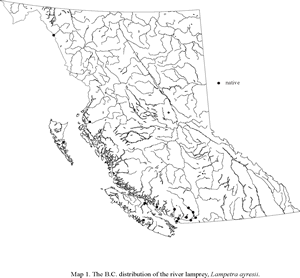Distinguished by 2 large teeth on the supraoral bar, a large middle tooth on the tongue, 3 points (rarely 2) on each central lateral tooth plate, and the absence of posterial teeth (Ref. 27547). Anterior dorsal fin being lower than posterior, the fins separate in nonbreeding individuals but coming into contact at spawning; caudal fin lobes about equal, lower lobe joined to anal fin; anal fin virtually absent in males (Ref. 27547). Dark brown or brownish gray on sides and back; belly yellowish, silvery around head, gill openings and lower sides; caudal fin has a band of dark pigment inside its margins, symmetrical on each lobe (Ref. 27547).
Source: FishBase. Page, L.M. and B.M. Burr 1991 A field guide to freshwater fishes of North America north of Mexico. Houghton Mifflin Company, Boston. 432 p.
